Atina Diffley's Blog: What Is A Farm? A Synthesis of the Land, People, and Business., page 3
December 11, 2012
Dear Valerie: Cigars and Tobacco Mosaic Virus
On Dec 4, 2012, at 6:02 PM, Valerie . . . wrote to Atina Diffley:
Hi Atina,
Firstly I LOVE your book!
My husband and a group of his friends get together about once a month and smoke cigars. Last summer one evening it was at our house and they smoked on the back deck which is level with and about 8′ away from my vegetable garden. I did not put it together with the smoking but my tomatoes were a total flop last year. Some people said it was blight. This year when the smoker was at our house it rained so they moved it to my front porch nowhere near my vegetable garden. I had a nice crop this year . . . actually still have kale growing. Before I become the wicked witch and ban the guys from smoking here do you think it was the tobacco mosaic you speak about on page 310 that messed up my crop last year. It seemed like no matter what I did they just seemed dehydrated. My husband suggested I contact you before I ban the smoker.
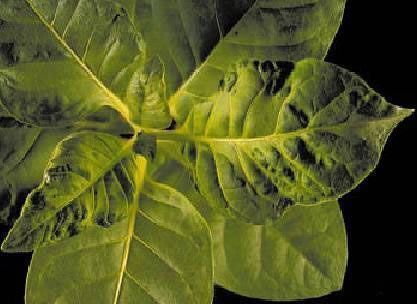
A tobacco plant infected with Tobacco Mosaic Virus.
Thank you!!
Valerie
On Dec 11, 2012 at 1:02 pm Atina Diffley responded:
Dear Valerie,
According to plant pathologists at the University of Minnesota, Tobacco Mosaic Virus is one of the most common plant virus diseases in Minnesota. The dreaded virus is transmittable to tomatoes via tobacco smoke, it can survive for up to 50 years in dried plant parts, and there are no efficient chemical or organic treatments that protect tomatoes from the infection or that eliminate viral infections from plant tissues once they do occur. Thus the only known controls are prevention, ie. limiting its spread. Detailed information from the University of Minnesota can be found here.
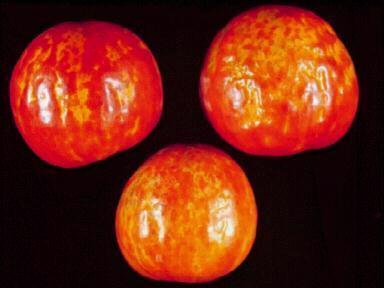
Typical mottling symptoms appearing on tomato fruit with Tobacco Mosaic Virus (photo John Paul Jones).
It is quite possible that your tomato plants suffered Tobacco Mosaic Virus, however, without the actual plants for physical identification and/or a lab tissue test I fear your claim could be rejected as specious. The plants could also have been infected with late or early blight, anthracnose, septoria leaf spot, fusarium or verticillium wilt, bacterial spot or speck or canker, or a host of other frightful tomato diseases. In fact, it is highly probable that a combination of pathogens caused your plant’s distress–they frequently operate in tandem.
Even if credible evidence were at hand, your advocacy for preventative health measures may be a challenging concept for people who smoke on a regular basis. Since you’ve read Turn Here Sweet Corn, you know I am a strong advocate for women not-giving-up-their-personal-power. I encourage you to carefully evaluate your goals, motives, and all involved parties’ personal agendas in this case while also considering the finances, food supply, and the health–both physical and emotional–of all your family members. (including pets and plants)
I am confident that once you are clear on your priorities you will be able to achieve an outcome based on what is best for you and your family. In the case of the Koch pipeline legal proceeding we were creating a first-of-its-kind organic mitigation plan, designed to “make an offense or crime less serious or more excusable, less harsh, severe, or violent,” and our livelihood and the food source of many eaters was threatened. A complete prohibition of smoke on pipeline worker’s clothes and bodies while working on our organic farm was our desired outcome.
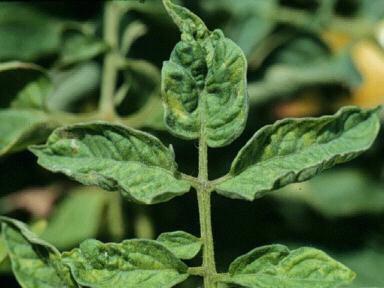
The leaves of a tomato plant with Tobacco Mosaic Virus exhibit a clear mosaic pattern.
In your case, cigars and spousal disagreement are an ancient and oft-repeated conflict, and compromise is likely possible as the smokers could choose a time of year before planting or after frost, or move to a different part of your home. Or you could choose to risk the crop knowing that there will be many farmers with tomatoes at the farmers market anxious to cash in on your husband’s habit and social life.
We have had another cigar experience that may be of use in your present situation. A female neighbor of ours was an antique collector and fed up with her husband’s daily cigar smoke. She told him that he could either stop smoking in the house, or build an additional room to store her antiques sans cigars. He choose the latter, a three season room was added onto the house, and she moved her antiques there. Their problem appeared to be solved, but then, ironically, the main house caught fire and was completely destroyed except for the added-on room, which survived the fire with the antiques intact. We purchased the room and moved it to our farm where it now serves as a summer cabin (non-smoking). While this story is clearly here-say when holding court with a Tabagie* it may serve as a helpful antidote to share in private with your husband if he resists a compromise and you wish to draw in further influence of a slightly hoodoo nature to emphasis your point.
Best to you and may your smoke issues be peacefully mitigated for your household and garden,
Sincerely, Atina Diffley
*Tabagie: A group of smokers who meet as a club, (1819).
© 2012 by Atina Diffley, All Rights Reserved.
Subscribe to Atina Diffley’s Blog, What Is A Farm?
Read Turn Here Sweet Corn | Amazon | Barnes & Noble | IndieBound | University of MN Press
Atina Diffley is an organic consultant (Organic Farming Works LLC), educator, public speaker, and author of the 2012 memoir, Turn Here Sweet Corn: Organic Farming Works, published by the University of Minnesota Press. Until 2008, she and her husband Martin ran the Gardens of Eagan, one of the first certified organic produce farms in the Midwest. One of her favorite things in the world is rain.

November 14, 2012
The Atina Diffley Kitchen and Give To CURE!
What could be better than having a kitchen named after oneself!

The Atina Diffley Kitchen in the Writer’s Retreat at CURE in Montevideo, MN.
Today is G IVE TO THE MAX DAY in Minnesota! On Thursday, November 15, every donation you make gives your favorite organizations the chance to win even more money. Here’s my pick for 2012. I hope you’ll join me in supporting CURE, a MN non-profit that is making a BIG difference.
IVE TO THE MAX DAY in Minnesota! On Thursday, November 15, every donation you make gives your favorite organizations the chance to win even more money. Here’s my pick for 2012. I hope you’ll join me in supporting CURE, a MN non-profit that is making a BIG difference.
CLEAN UP THE RIVER ENVIRONMENT is doing quadruple duty. There’s our precious Water, CURE is leading the charge in cleaning up the Minnesota River. They protect Soil. To clean up the river they work to create more living cover on the land–they want more buffer strips everywhere! And Fertilizer–a lot of “nutrients” get into the river by attaching themselves to soil particles, so keeping the soil covered can help stop nutrient pollution as well. And on top of all that CURE supports Writers!
Upstairs of their office in downtown Montevideo CURE has built a writers retreat which they graciously made available to me when I started writing Turn Here Sweet Corn. Each of the retreat rooms are named after authors. There’s the Paul Gruchow Parlor, and the Joseph Amato Study, Joe and Nancy Paddock have a hall named after them, and I slept in the Florence Dacey Bedroom when I wrote there. The Athena Kildegaard Bedroom is just down the hall, and now I am absolutely tickled, pleased giddy-silly, and honored red to be part of this amazing group of passionate writers and to tell you that the the Atina Diffley Kitchen has recently been christened!!!
writing Turn Here Sweet Corn. Each of the retreat rooms are named after authors. There’s the Paul Gruchow Parlor, and the Joseph Amato Study, Joe and Nancy Paddock have a hall named after them, and I slept in the Florence Dacey Bedroom when I wrote there. The Athena Kildegaard Bedroom is just down the hall, and now I am absolutely tickled, pleased giddy-silly, and honored red to be part of this amazing group of passionate writers and to tell you that the the Atina Diffley Kitchen has recently been christened!!!

Turn Here Sweet Corn ready to infiltrate cereal bowls in the Atina Diffley Kitchen!
So next time you’re in Western Minnesota, swing into downtown Montevideo and stop at CURE to see what’s cooking . . . in the meantime,
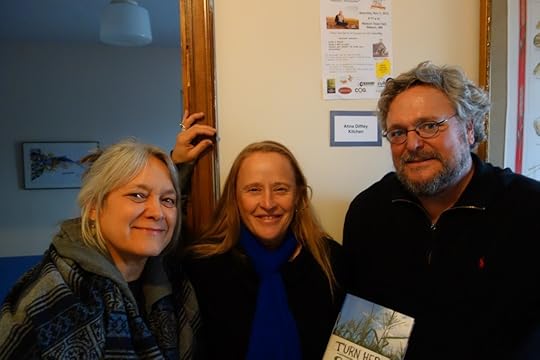
Audrey Arner, Atina Diffley, and Patrick Moore at the “Atina Diffley Kitchen” christening at CURE in Montevideo.
Click Here to Support CURE – Give to the Max November 15

August 27, 2012
GMO Sweet Corn Varieties and Genetic-Contamination – Just Label It!
In Turn Here Sweet Corn: Organic Farming Works, I wrote about cross-pollination and the threat of genetically modified organisms.
If our sweet corn is cross-pollinated by neighboring field corn, it is not sweet nor is it marketable. Martin manages this threat by recording the dates of all the developmental stages for our crop, as well as the neighbors’ planting and pollen dates. He then adjusts his varieties and planting sequence by what the neighbors plant and when. But genetic contamination is impossible to avoid completely. When there are field corn–pollinated kernels in our sweet corn, they are visible; dark yellow kernels mixed in like polka dots among the small, tender sweet corn kernels. But now there is an even larger challenge and looming threat.
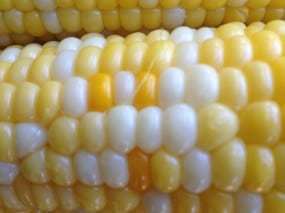
Cross–pollination/genetic-contamination in our organic, bio-color sweet corn seed breeding project in August, 2012. The three dark yellow kernels were cross-pollinated by field corn — 88% chance that it is GMO.
It is 1997, and our neighbors are experimenting with genetically modified field corn (GMO). We don’t want GMO traits in our organic crops, and there is no controlling the pollen. We know from firsthand experience how readily cross-pollination occurs. We are concerned that eventually it will become impossible to find seed and food that isn’t contaminated with GMO traits. — excerpt Turn Here Sweet Corn
I was concerned in 1997, but I couldn’t even imagine then that by 2012 the U.S. Department of Agriculture would report that 88 percent of corn raised in the United States is grown from what scientists now call transgenic seed (a.k.a. GMO, or GE for genetically engineered.)
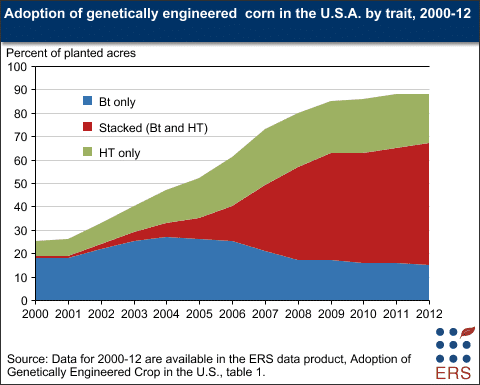
BT: Insect-resistant crops containing the gene from the soil bacterium Bt
HT: Herbicide-tolerant (HT) crops, developed to survive application of specific herbicides that previously would have destroyed the crop along with the targeted weeds.
 Cross-pollination
Cross-pollinationAs careful as we are about planting dates, cross-pollination in a corn-growing region is inevitable — pollen can travel long distances on wind.
Each kernel has it’s own silk. A pollen grain must travel down 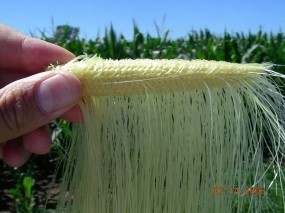 each silk to pollinate each kernel. One ear of corn can be pollinated from multiple plants.
each silk to pollinate each kernel. One ear of corn can be pollinated from multiple plants.
And for those of us that wish to avoid eating GMO traits, the threat isn’t only from GMO field corn pollen. Many local, non-organic* sweet corn producers — YES, “people-corn”, not only “cow-corn,” and YES, even at local farmers markets — are now planting GMO sweet corn varieties.
I find that often when I ask the market sales person if their corn has GMO traits they say “no,” or “what is GMO?” But when I speak to the farmer I learn that it is a GMO variety. The sales staff don’t always know, and labeling is not yet required.
(*Organic farmers are not allowed to use genetically modified seed.)
Sweet Corn Variety Descriptions From Our Local MN Vegetable Seed Supplier.
*ATTRIBUTE VARIETIES – Insect Resistance for European Corn Borer & Corn Earworm
*IMPORTANT – When buying ATTRIBUTE varieties, _ _ _ _ SEEDS, INC must have the waiver before seed can be released. Contact us for waiver.
ATTRIBUTE VARIETIES
Insect Resistance Price per thousand (M)
DAYS
EAR SIZE
ROW
HEIGHT
DESCRIPTION
25M
GH08511
(S.E.xSh2)
80
8×1.8″
16
6.5′
YELLOW, triplesweet, good husk protection & disease package
$9.18
BC 0801
(S.E.)
79
8×2″
16-18
6.5′
BI-COLOR, good tip fill, good disease package
$8.50
Was it clear to you from reading this description that Attribute Varieties are genetically modified with BT?
Would you like them to be labeled in the market so you can choose if you want to eat them or not?
How about this one?
*PERFORMANCE SERIES corn provides control for Fall Armyworm, Corn Earworm, European Corn – Southwestern Corn – Sugar Cane – Southern Cornstalk & Common Stalk Borer, Western Corn & Northern Corn Rootworm Larvae. Also tolerant to ROUNDUP WEATHER MAX & ROUNDUP POWER MAX.
*PERFORMANCE SERIES can only be shipped upon receiving your TECHNOLOGY LICENSE number. We will send you the LICENSING AGREEMENT if you don’t have one already.
PERFORMANCE SERIES
Advanced Insect Resistance – Roundup Ready Price per thousand (M)
DAYS
EAR SIZE
ROW
HEIGHT
DESCRIPTION
25M
Obsession II
(AuSh2)
79
8.5″
16-20
6.5′
BICOLOR
less $2 rebate = $11.12 M
$13.12
Passion II
(AuSh2)
81
8×1.7″
18-20
6.5′
YELLOW
less $2 rebate = $11.12 M
$13.12
Temptation II
(S.E.)
70
7.7×1.7″
14-16
6.5′
BICOLOR
less $2 rebate = $9.65 M
$11.65
The PERFORMANCE SERIES is “pyramided” or “stacked” — meaning it has multiple GMO traits — BT insect control AND HT Round-up herbicide resistance.
GMO BT sweet corn has been on the market for years, but the addition of herbicide resistant has make it “irresistible;” a grower can now use the same herbicide and sprayer on their field corn and their sweet corn — they don’t even have to rinse out the tank!
Do you want to eat sweet corn with Round-up herbicide and GMO traits?
Myself, I prefer organic butter and sea salt.
When I spoke with the seed vendor he told me that he had no idea that the Performance series would sell so well — he repeatedly sold out this spring. He added that even the Monsanto sales rep wasn’t expecting the high sales!
Genetic modification is an experiment not of our choosing. But we all are participants. It’s not if cross-pollination happens but when. There is no taking it back, and segregation in the field is not possible. It is a threat not just to our survival but also to the future of our genetic heritage and to nature itself.
Just Label It. We have the right to know.
Top 10 Lies Told by Monsanto on GMO Labeling in California, Michele Simon
Who’s funding opposition and support for Labeling Prop 37
Sign Prop 37 petition.
Right To Know Minnesota
© 2012 by Atina Diffley, All Rights Reserved.
Subscribe to Atina Diffley’s Blog, What Is A Farm?
Read Turn Here Sweet Corn | Amazon | Barnes & Noble | IndieBound | University of MN Press
Atina Diffley is an organic consultant (Organic Farming Works LLC), educator, public speaker, and author of the 2012 memoir, Turn Here Sweet Corn: Organic Farming Works, published by the University of Minnesota Press. Until 2008, she and her husband Martin ran the Gardens of Eagan, one of the first certified organic produce farms in the Midwest. One of her favorite things in the world is rain.

August 25, 2012
GMO Sweet Corn Varieties and Genetic-Contamination – Just Label It!
In Turn Here Sweet Corn: Organic Farming Works, I wrote about cross-pollination and the threat of genetically modified organisms.
If our sweet corn is cross-pollinated by neighboring field corn, it is not sweet nor is it marketable. Martin manages this threat by recording the dates of all the developmental stages for our crop, as well as the neighbors’ planting and pollen dates. He then adjusts his varieties and planting sequence by what the neighbors plant and when. But genetic contamination is impossible to avoid completely. When there are field corn–pollinated kernels in our sweet corn, they are visible; dark yellow kernels mixed in like polka dots among the small, tender sweet corn kernels. But now there is an even larger challenge and looming threat.
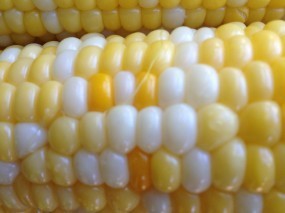
Cross–pollination/genetic-contamination in our organic, bio-color sweet corn seed breeding project in August, 2012. The three dark yellow kernels were cross-pollinated by field corn — 88% chance that it is GMO.
It is 1997, and our neighbors are experimenting with genetically modified field corn (GMO). We don’t want GMO traits in our organic crops, and there is no controlling the pollen. We know from firsthand experience how readily cross-pollination occurs. We are concerned that eventually it will become impossible to find seed and food that isn’t contaminated with GMO traits. — excerpt Turn Here Sweet Corn
I was concerned in 1997, but I couldn’t even imagine then that by 2012 the U.S. Department of Agriculture would report that 88 percent of corn raised in the United States is grown from what scientists now call transgenic seed (a.k.a. GMO, or GE for genetically engineered.)
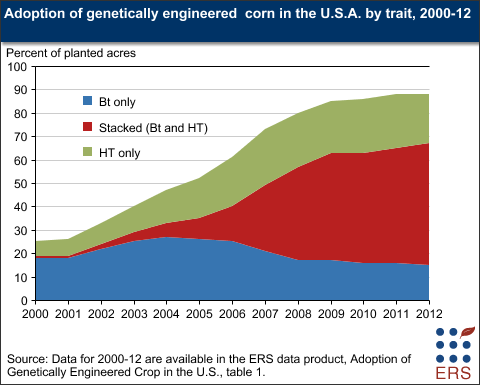
BT: Insect-resistant crops containing the gene from the soil bacterium Bt
HT: Herbicide-tolerant (HT) crops, developed to survive application of specific herbicides that previously would have destroyed the crop along with the targeted weeds.
 Cross-pollination
Cross-pollinationAs careful as we are about planting dates, cross-pollination in a corn-growing region is inevitable — pollen can travel long distances on wind.
Each kernel has it’s own silk. A pollen grain must travel down 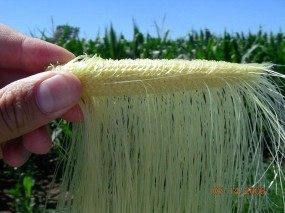 each silk to pollinate each kernel. One ear of corn can be pollinated from multiple plants.
each silk to pollinate each kernel. One ear of corn can be pollinated from multiple plants.
And for those of us that wish to avoid eating GMO traits, the threat isn’t only from GMO field corn pollen. Many local, non-organic* sweet corn producers — YES, people corn, not only cow corn, and YES, even at local farmers markets — are now planting GMO sweet corn varieties.
I find that often when I ask the market sales person if their corn has GMO traits they say “no,” or “what is GMO?” But when I speak to the farmer I learn that it is a GMO variety. The sales staff don’t always know, and labeling is not yet required.
(*Organic farmers are not allowed to use genetically modified seed.)
Sweet corn variety descriptions from a local MN vegetable seed supplier.
*ATTRIBUTE VARIETIES – Insect Resistance for European Corn Borer & Corn Earworm
*IMPORTANT – When buying ATTRIBUTE varieties, _ _ _ _ SEEDS, INC must have the waiver before seed can be released. Contact us for waiver.
ATTRIBUTE VARIETIES
Insect Resistance Price per thousand (M)
DAYS
EAR SIZE
ROW
HEIGHT
DESCRIPTION
25M
GH08511
(S.E.xSh2)
80
8×1.8″
16
6.5′
YELLOW, triplesweet, good husk protection & disease package
$9.18
BC 0801
(S.E.)
79
8×2″
16-18
6.5′
BI-COLOR, good tip fill, good disease package
$8.50
Was it clear to you from reading this description that Attribute Varieties are genetically modified with BT?
Would you like them to be labeled in the market so you can choose if you want to eat them or not?
How about this one?
*PERFORMANCE SERIES corn provides control for Fall Armyworm, Corn Earworm, European Corn – Southwestern Corn - Sugar Cane – Southern Cornstalk & Common Stalk Borer, Western Corn & Northern Corn Rootworm Larvae. Also tolerant to ROUNDUP WEATHER MAX & ROUNDUP POWER MAX.
*PERFORMANCE SERIES can only be shipped upon receiving your TECHNOLOGY LICENSE number. We will send you the LICENSING AGREEMENT if you don’t have one already.
PERFORMANCE SERIES
Advanced Insect Resistance – Roundup Ready Price per thousand (M)
DAYS
EAR SIZE
ROW
HEIGHT
DESCRIPTION
25M
Obsession II
(AuSh2)
79
8.5″
16-20
6.5′
BICOLOR
less $2 rebate = $11.12 M
$13.12
Passion II
(AuSh2)
81
8×1.7″
18-20
6.5′
YELLOW
less $2 rebate = $11.12 M
$13.12
Temptation II
(S.E.)
70
7.7×1.7″
14-16
6.5′
BICOLOR
less $2 rebate = $9.65 M
$11.65
The PERFORMANCE SERIES is “pyramided” or “stacked” — meaning it has multiple GMO traits — BT insect control AND HT Round-up herbicide resistance.
GMO BT sweet corn has been on the market for years, but the addition of herbicide resistant has make it “irresistible;” a grower can now use the same herbicide and sprayer on their field corn and their sweet corn — they don’t even have to rinse out the tank!
Do you want to eat sweet corn with Round-up herbicide and GMO traits?
Myself, I prefer organic butter and sea salt.
When I spoke with the seed vendor he told me that he had no idea that the Performance series would sell so well — he repeatedly sold out this spring. He added that even the Monsanto sales rep wasn’t expecting the high sales!
Genetic modification is an experiment not of our choosing. But we all are participants. It’s not if cross-pollination happens but when. There is no taking it back, and segregation in the field is not possible. It is a threat not just to our survival but also to the future of our genetic heritage and to nature itself.
Just Label It. We have the right to know.
Top 10 Lies Told by Monsanto on GMO Labeling in California, Michele Simon
Who’s funding opposition and support for Labeling Prop 37
Sign Prop 37 petition.
Right To Know Minnesota
© Atina Diffley 2012
Subscribe to Atina Diffley’s Blog, What Is A Farm?
Read Turn Here Sweet Corn | Amazon | Barnes & Noble | IndieBound | University of MN Press
Atina Diffley is an organic consultant (Organic Farming Works LLC), educator, public speaker, and author of the 2012 memoir, Turn Here Sweet Corn: Organic Farming Works, published by the University of Minnesota Press. Until 2008, she and her husband Martin ran the Gardens of Eagan, one of the first certified organic produce farms in the Midwest. One of her favorite things in the world is rain.

August 21, 2012
Organic Certification Cost Share Program
Minnesota’s organic certification cost share program is now accepting applications!
Often I hear that farmers decide to not certify because of the cost, and when I tell them about the federal cost share program — which can rebate up to 75 percent of the cost of their organic certification — they were not aware of it. If you are a supporter of an organic farm, you can support them but letting them know about this opportunity. Farmers: this is a federal program, check with your state’s department of agriculture to learn their process and timing.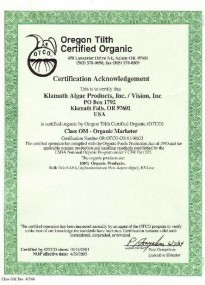
Organic certification is a third-party verification system that assures consumers that the organic products they buy are truly organic, produced in compliance with federal organic regulations. Organic operations are monitored through review of their records and on-site inspections at least once a year. Additional benefits of certification include, sending a clear message to the USDA — farmers are growing organically and consumers are buying it, legal protection for farmers, and protection from co-opting.
“The cost share program provides some regulatory relief from a financial burden that is unique to organic farms and other organic businesses,” said MDA Organic Program Administrator Meg Moynihan. “Organic growers and processors who sell more than $5,000 of organic agricultural products are legally required to obtain certification at their own expense. Depending on the farm or business size, the cost ranges from hundreds to thousands of dollars per year, so this program can be a big help.”
Funds for the cost share program come from a cooperative agreement with the United States Department of Agriculture (USDA). Operations that received certification (or had ongoing certification) between October 1, 2011 and September 30, 2012 are eligible for reimbursement of up to 75 percent of certification-related costs up to a maximum of $750 per category (crop, livestock, processing/handling, wild harvest). Last year, the MDA disbursed nearly $381,000 to 480 certified organic farmers and processors in the state.
To qualify, applicants must be certified by a USDA-accredited certifying agency. The MDA has already mailed application packets to more than 900 certified organic operations in the state. Any certified organic farmer or processor who did not receive a packet can obtain all the program details and necessary materials on the MDA’s web site www.mda.state.mn.us/organic or by calling 651-201-6012. Deadline: October 31, 2012.
1) Certification Sends A Clear Message To The USDA
(Reposted from July 30, 2012, Organic Certification Supports And Protects Farmers And The Organic Movement)
Farmers are growing organically and consumers are buying it. The USDA tracks the number of certified organic farms. A growing, quantifiable number of certified organic farms is a strong indicator that organic production is viable: that farmers are achieving it, that consumers want it, and that organic must be supported with research, farm support payments, insurance, and cost share funds. Certification supports the organic movement and is a crucial element in the transition to an organic agricultural system.
2) Certification Provides Legal Protection.
Every certified organic farm has an Organic System Plan (OSP)—unique and specific to their individual farm. As an inspected, certified, and federally registered document, an OSP is a respected and credible document in a court of law. Without certification, production claims and statements are hearsay and unconfirmed in a court of law.
1. Chemical Trespass: Minnesota organic farmers Oluf and Debra Johnson had success in 2011 when the Minnesota Court of Appeals ruled that an organic farm surrounded by chemical-laden conventional farms can seek damages for lost crops, as well as lost profits, caused by the illegal trespassing of pesticides and herbicides on its property.
2. Eminent Domain: In 2006 our organic farm succeeded in a legal proceeding against one of the largest privately owned company in the world, Koch Industries. Because the farm—Gardens of Eagan—was certified, we were able to prevent a crude oil pipeline from crossing our organic fields, and work with the Minnesota Department of Agriculture and the Minnesota Public Utilities Commission to create and implement an organic mitigation plan providing protections to all certified organic farms in Minnesota. Certification was crucial to this success.
3) Certification Provides Protection From Co-opting
As the market grows, more conventional and industrial companies and farms are developing “local” and “sustainable” products with glorious labels, professional promotion plans, and prices far lower than any small, organic farmer can produce. Organic certification is crucial to differentiate product and protect farmers and consumers alike from this green washing and eroding of the local and sustainable market.
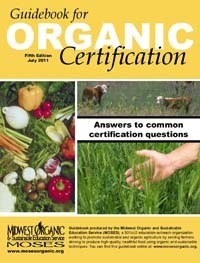
Interested in growing organic? Start here!
MOSES ORGANIC CERTIFICATION GUIDEBOOK.
This 36-page guidebook will answer your questions about organic certification! From general production questions, to a discussion on approved materials, this guidebook is an indispensable resource.
The guide includes listings of:
1. Steps to Certification
2. Certification Agencies
3. Helpful Organizations
4. Resources for Transitioning
5. Organic Research
© Atina Diffley 2012
Subscribe to Atina Diffley’s Blog, What Is A Farm?
Read Turn Here Sweet Corn| Amazon | Barnes & Noble | IndieBound | University of MN Press
Atina Diffley is an organic consultant (Organic Farming Works LLC), educator, public speaker, and author of the 2012 memoir, Turn Here Sweet Corn: Organic Farming Works, published by the University of Minnesota Press. Until 2008, she and her husband Martin ran the Gardens of Eagan, one of the first certified organic produce farms in the Midwest. One of her favorite things in the world is rain.

August 2, 2012
Minnesota Supreme Court Reverses Pesticide Trespass Ruling
Sad News. I wrote in a post on Monday
1. Chemical Trespass: Minnesota organic farmers Oluf and Debra Johnson had success in 2011 when the Minnesota Court of Appeals ruled that an organic farm surrounded by chemical-laden conventional farms can seek damages for lost crops, as well as lost profits, caused by the illegal trespassing of pesticides and herbicides on its property.
The Minnesota Supreme Court reversed the 2011 appeals court ruling last Wednesday, stating that Minnesota does not recognize trespassing by “particulate matter and ruling that chemicals drifting from one farm to another do not constitute trespassing under state law. This decision could make it harder for organic farmers to seek relief if crops are damaged by pesticide drift. Read Article
We should have a right to a pesticide free environment, but we don’t. Not yet anyway. Vande Vegte, the Johnsons’ attorney, said he plans to take the case forward. There will be more of these cases in the years ahead.

July 30, 2012
Organic Certification Supports And Protects Farmers And The Organic Movement
If a farm growing to organic standards has a direct relationship with its customers, and has built trust, credibility, and a reliable market, does certification matter? What are the benefits to farmers, and how does certification contribute to supporting the transition to an organic agricultural system?
1) Certification Provides Protection From Co-opting
As the market grows, more conventional and industrial companies and farms are developing “local” and “sustainable” products with glorious labels, professional promotion plans, and prices far lower than any small, organic farmer can produce. Organic certification is crucial to differentiate product and protect farmers and consumers alike from this green washing and eroding of the local and sustainable market.
2) Certification Provides Legal Protection.
Every certified organic farm has an Organic System Plan (OSP)—unique and specific to their individual farm. As an inspected, certified, and federally registered document, an OSP is a respected and credible document in a court of law. Without certification, production claims and statements are hearsay and unconfirmed in a court of law.
1. Chemical Trespass: Minnesota organic farmers Oluf and Debra Johnson had success in 2011 when the Minnesota Court of Appeals ruled that an organic farm surrounded by chemical-laden conventional farms can seek damages for lost crops, as well as lost profits, caused by the illegal trespassing of pesticides and herbicides on its property.
2. Eminent Domain: In 2006 our organic farm succeeded in a legal proceeding against one of the largest privately owned company in the world, Koch Industries. Because the farm—Gardens of Eagan—was certified, we were able to prevent a crude oil pipeline from crossing our organic fields, and work with the Minnesota Department of Agriculture and the Minnesota Public Utilities Commission to create and implement an organic mitigation plan providing protections to all certified organic farms in Minnesota. Certification was crucial to this success.
3) Certification Sends A Clear Message To The USDA
Farmers are growing organically and consumers are buying it. The USDA tracks the number of certified organic farms. A growing, quantifiable number of certified organic farms is a strong indicator that organic production is viable: that farmers are achieving it, that consumers want it, and that organic must be supported with research, farm support payments, insurance, and cost share funds. Certification supports the organic movement and is a crucial element in the transition to an organic agricultural system
National Organic Cost Share Program
Affordability of certification is an issue many organic organizations have worked long and hard to ensure through the National Organic Cost Share Program, authorized and appropriated by Congress through the Farm Bill. Certified entities (handlers as well as farmers) are eligible for up to 75% cost share per category for their cost of certification.
Advocate For Organic Farmers
The present 2012 House farm bill would eliminate the National Organic Certification Cost Share Program. Speak up for organic support in the 2012 farm bill. Sign up for action alerts on the Certification Cost Share Program and other issues important to organic farmers and consumers from National Sustainable Agricultural Coalition (NSAC).
© Atina Diffley 2012
Read Part l. A Brief History Of Organic Certification
Subscribe to Atina Diffley’s Blog, What Is A Farm?
Read Turn Here Sweet Corn| Amazon | Barnes & Noble | IndieBound | University of MN Press
Atina Diffley is an organic consultant (Organic Farming Works LLC), educator, public speaker, and author of the 2012 memoir, Turn Here Sweet Corn: Organic Farming Works, published by the University of Minnesota Press. Until 2008, she and her husband Martin ran the Gardens of Eagan, one of the first certified organic produce farms in the Midwest. One of her favorite things in the world is rain.

Organic Certification Supports And Protects Farmers And The Organic Movement
In the 1970s the supply of organically grown food was limited or largely unobtainable. Early organic farmers were often isolated and faced harassment and ridicule in their communities. Two of the greatest challenges at the time were a lack of organic production information, and different opinions on what the term “organic” should mean. “Organic” was used loosely; much like the word “natural” is used today.
Organic farmers and consumers quickly saw the necessity of developing consistent organic standards and a third-party certification process. Certification groups were started throughout the country, and farmers and consumers worked together to write standards defining organic. Criteria based on the premise that “organic farming will do no harm” were used in writing standards for soil, livestock, and human health. The impacts of conventional farming on biological diversity, birds and other wildlife, erosion, and the land itself, were critical considerations in these diverse discussions. By bringing growers and buyers together, commonality, consistency, and a fundamental organic certification system and methodology was created.
In the 1980s, many states passed organic laws, but a major challenge remained. Each certifying organization and state had its own standards, causing a lack of uniformity and reciprocity issues from certifier to certifier. A single national standard was crucial to prevent confusion in the marketplace and to protect against mislabeling or fraud. In 1989 the Organic Working Group, made up of twenty-five consumer, farmer, environmental, and animal protection organizations, began to work on federal organic standards. It took until 2002 and a huge amount of effort and consumer involvement to obtain federal organic standards.
Today’s Organic Market
Now it’s 2012 and organic food can be found in most mainstream markets. We have come a long way! The Organic Trade Association reports 2010 organic sales as 4% of total food sales, up from only 1.2% of food sales in 2000. Fruits and vegetables are the leading organic sector, representing nearly 12% of all U.S. fruit and vegetable sales. And these numbers include only certified organic farms. There are many more farmers growing with organic methods that have not obtained certification, and thus are not included in these statistics.
Organic is the future. It is our security. We know that to be sustainable an agricultural system must protect and preserve the soil and water and biological diversity and be based on renewable fertility.
Posting Tomorrow: Part ll. Does Certification Matter? . . .
© Atina Diffley 2012
Subscribe to Atina Diffley’s Blog, What Is A Farm?
Read Turn Here Sweet Corn| Amazon | Barnes & Noble | IndieBound | University of MN Press
Atina Diffley is an organic consultant (Organic Farming Works LLC), educator, public speaker, and author of the 2012 memoir, Turn Here Sweet Corn: Organic Farming Works, published by the University of Minnesota Press. Until 2008, she and her husband Martin ran the Gardens of Eagan, one of the first certified organic produce farms in the Midwest. One of her favorite things in the world is rain.

July 20, 2012
Deleted Scene — Turn Here Sweet Corn — Maize’s Cucumber Pick
Chapter: What To Hold Onto
Maize is racing barefoot up the old horse path from Louise’s field. Something tiny and green is flinging from an ice cream bucket swinging wildly at his side. He sings up to me stocking corn at the roadside stand, “I picked the cucumbers.”
He must be pretending with new growth pine cones. It will be at least ten days before the cucumbers are mature enough to harvest. The male blossoms have been open for a week, but the female flowers just opened a few days ago and it’s been so cool and wet, I doubt the bees and native pollinators have even been working.
Then I see them clearly—the bucket is full to the top—thin, one-inch, just-on-the-start to becoming cucumbers. How could a five-year old who can’t even pick up a few legos have the patience to pick an entire gallon of something so miniature?
My throat expands as if jammed with an over mature, yellow and hard slicer. We coddled the plants through early cool spring with row covers. These would have grown into the first picking: crucial early-cash-flow and first jump in the market, establishing us as reliable and consistent cucumber providers.
He is absolutely beaming. What’s more important: the money and market, or Maize’s sense of farm family involvement? I can clearly see that he believes it is a big surprise and contribution. I look for something to praise but all air has left me.
“Wow, you really have stick–to–it–ness.” I stutter, “That’s a lot of cucumbers.”
I can’t force myself to use the word thanks.
We arrange the miniature fruit in tidy rows in half pint containers. They are so tiny; it takes three to make a row, seven rows to make a layer, and five layers to fill to the top. He places each cucumber gently, lining it up; blossom end to the right, stem end to the left. His tiny fingers look proportionately perfect with the small fruit pinched between his thumb and forefinger. He stops often to scratch his hands and arms. They are a mess of shallow scratches from the prickly vines, but doesn’t complain or comment. He writes $1 on a price card and thumbnails it in front of the display. We step back and admire his work from the customer’s perspective. “Its beautiful,” he whispers.
“People will love these for the first buy—tender and sweet. We’ll let the next batch get big, as long as from your elbow to the tips of you fingers. I’ll tell you when they are ready.”
And then I can say it, “Thanks Maize. You are a crucial part of our family.”
© Atina Diffley 2012
Subscribe to Atina Diffley’s Blog
Read Turn Here Sweet Corn| Amazon | Barnes & Noble | IndieBound | University of MN Press
Atina Diffley is an organic consultant (Organic Farming Works LLC), educator, public speaker, and author of the 2012 memoir, Turn Here Sweet Corn: Organic Farming Works, published by the University of Minnesota Press. Until 2008, she and her husband Martin ran the Gardens of Eagan, one of the first certified organic produce farms in the Midwest. For reflections, tips and decision-making tools subscribe to her on-line blog, What Is A Farm.

July 9, 2012
Upcoming Events With Atina Diffley
Monday, July 9, 6-8 PM
Midtown Global Market (920 East Lake Street on the corner of Lake & 10th Avenue South, Minneapolis, MN 55407) in the Greenway Conference Room.
Successful weed management in an organic system requires much more than good cultivation. Atina Diffley will discuss weed physiology and management using rotations, seed bed reduction, fertility, stale bedding making, cover crops, habitat for biological life, and tillage, in relation to the agronomic principles of an organic vegetable farming system.
Hosted by the Women’s Environmental Institute WEI
For More Information
Beth Hatch, Women’s Environmental Institute
651.583.0705 (o)
wei@w-e-i.org
Turn Here Sweet Corn: Organic Farming Works Book Talk and Signing
Tuesday, July 10, 2012 6:30 – 8 pm
Valley Natural Foods, 13750 County Road 11, Burnsville, MN 55337, 952-891-1212, #236
This a FREE event but you must RSVP by end of day, Monday, July 9. 952-891-1212, #236
Join local organic author of Turn Here Sweet Corn: Organic Farming Works, Atina Diffley, for a conversation on agriculture and biological diversity that leads right to our plates and the land that feeds us. Atina will read from her new book and talk about biological diversity, her family’s experience as organic farmers when their original Eagan land was lost to development in the early 1990s, and the power of consumers to make a difference.
A viewing of clips from the video documentary, Turn Here Sweet Corn, a Q&A session, and a book signing will follow her presentation.
Also, enjoy appetizers and fun treats catered by Valley Natural Foods.

What Is A Farm? A Synthesis of the Land, People, and Business.
- Atina Diffley's profile
- 12 followers




